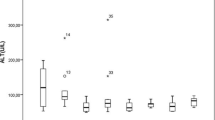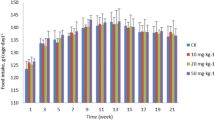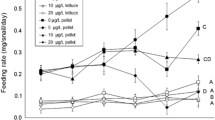Abstract
Diets supplemented with 0.01 or 0.05 ppm (mg/kg) of 3,4,5,3′,4′,5′-hexachlorobiphenyl (345-HCB) were fed to mink to investigate the toxicological manifestations of this toxic polychlorinated biphenyl congener in a sensitive species. Dietary exposure of mink to 0.05 ppm 3,4,5,3′,4′,5′-hexachlorobiphenyl for 135 days resulted in 50% mortality while no deaths occurred on 0.01 ppm 345-HCB. Clinical signs of toxicity included anorexia, bloody stools, disrupted molting patterns, and thickened, elongated and deformed nails. Ascites and gastric ulcers were present in animals that died. Statistically significant increases in liver, kidney, and adrenal gland weights were found in the 345-HCB-treated mink. Decreases in total and free triiodothyronine concentrations were observed in mink fed the 345-HCB-treated diets and total thyroxine was decreased in the mink fed 0.05 ppm 345-HCB. No consistent histopathologic lesions were found in the thyroid or adrenal glands of the 345-HCB-treated mink, nor were there any statistically significant differences between the 345-HCB-treated and the control mink in serum epidermal growth factor levels, plasma 17β-estradiol and progesterone concentrations, hepatic aminopyrine N-demethylase, and benzo(α)pyrene hydroxylase activities, hypothalamic norepinephrine, dopamine, and serotonin concentrations or in the incorporation of (3H) thymidine by concanavalin-A-stimulated lymphocytes.
Similar content being viewed by others
References
Anders AM, Mannering GJ (1966) Kinetics of inhibition of the N-de-methylation of ethylmorphine by 2-diethylaminoethyl 2,2-diphenylvalerate HCl (SKF-525A) and related compounds. Mol Pharmacol 2:319–327
Aulerich RJ, Ringer RK (1977) Current status of PCB toxicity to mink and effects on their reproduction. Arch Environ Contam Toxicol 5:279–292
Aulerich RJ, Bursian SJ, Breslin WJ, Olson BA, Ringer RK (1985) Toxicological manifestations of 2,4,5,2′,4′,5′-, 2,3,6,2′,3′,6′-, and 3,4,5,3′,4′,5′-hexachlorobiphenyl and Aroclor® 1254 in mink. J Toxicol Environ Health 15:63–79
Bastomsky CH (1974) Effects of a polychlorinated biphenyl mixture (Aroclor® 1254) and DDT on biliary thyroxine excretion in rats. Endocrinology 95:1150–1155
— (1977) Enhanced thyroxine metabolism and high uptake goiters in rats after a single dose of 2,3,7,8-tetrachlorodibenzo-p-dioxin. Endocrinology 101:292–296
Bissonnette TH, Wilson E (1939) Shortening daylight periods between May 15 and September 12 and the pelt cycle of the mink. Science 89:418–419
Bleavins MR, Aulerich RJ, Ringer RK (1980) Polychlorinated biphenyls (Aroclor® 1016 and 1242): Effects on survival and reproduction in mink and ferrets. Arch Environ Contam Toxicol 9:627–635
Bleavins MR, Aulerich RJ, Ringer RK, Bell TG (1982) Excessive nail growth in the European ferret induced by Aroclor® 1242. Arch Environ Contam Toxicol 11:305–312
Bleavins MR, Aulerich RJ (1983) Immunotoxicologic effects of polychlorinated biphenyls on the cell-mediated and humoral immune systems. Residue Reviews 90:57–67
Bleavins MR, Aulerich RJ, Ringer RK (1983) Hexachlorobenzene induced effects on the lymphocyte blastogenic response to concanavalin A in the mink and European ferret. Environ Toxicol Chem 2:411–418
Collins WT Jr, Capen CC (1980) Biliary excretion of125I-thyroxine and fine structural alterations in the thyroid glands of Gunn rats fed polychlorinated biphenyls (PCB). Lab Invest 43:158–164
Convey EM, Beck TW, Neitzel RR, Bostwick EF, Hafs HD (1977) Negative feedback control of bovine serum luteinizing hormone (LH) concentration from completion of the preovulatory LH surge until resumption of luteal function. J Animal Sci 46(4):792–796
Duby RT, Travis HF (1972) Photoperiodic control of fur growth and reproduction in the mink (Mustela vison). J Exptl Zool 182(2):217–225
Gerloff BJ, Herdt TH, Wells WW, Nachreiner RF, Emery RS (1986) Inositol and hepatic lipidosis II. Effect of inositol supplementation and time from parturition on serum insulin, thyroxine, and triiodothyronine and their relationship to serum and liver lipids in dairy cows. J Animal Sci (in press)
Gill JL (1978) Design and Anlysis of Experiments in the Animal and Medical Sciences, Vol. I, Iowa State University Press, Ames, IA, 409 pp
Green MR, Phil D, Couchman JR (1984) Distribution of epidermal growth factor receptors in rat tissues during embryonic skin development, hair formation, and the adult hair growth cycle. J Invest Dermatol 83:118–123
Jackson TF, Haibert FL (1974) A toxic syndrome associated with the feeding of polybrominated biphenyl contaminated concentrate to dairy cattle. J Am Vet Med Assn 165:437–439
Jacobowitz DM, Richardson JS (1978) Method for the determination of norepinephrine, dopamine, and serotonin in the same brain region. Pharmacol Biochem Behav 8:515–519
McKinney JD, Chae K, McConnell EE, Birbaum LS (1985) Structure-induction versus structure-toxicity relationships for polychlorinated biphenyls and related aromatic hydrocarbons. Environ Health Perspect 60:57–68
Moore GPM, Panaretto BA, Robertson D (1981) Effects of epidermal growth factor on hair growth in the mouse. J Endocrinol 88:293–299
—, (1982) Inhibition of wool growth in merino sheep following administration of mouse epidermal growth factor and a derivative. Aust J Biol Sci 35:163–172
—, (1983) Epidermal growth factor delays the development of the epidermis and the hair follicles of mice during growth of the first coat. Anat Rec 205:47–55
Moore GPM, Panaretto BA, Wallace ALC (1984) Treatment of ewes at different stages of pregnancy with epidermal growth factor: Effects on wool growth and plasma concentrations of growth hormone, prolactin, placental lactogen, and thyroxine and on foetal development. Acta Endocrinol 105:558–566
Moore JA (1979) The immunotoxicity phenomena. Drug Chem Toxicol 2:1–4
Nowicki HG, Norman AW (1972) Enhanced hepatic metabolism of testosterone, 4-andostene-3,17-dione, and estradiol-17β in chickens pretreated with DDT or PCB. Steroids 19:85–99
Pazdernik TL, Rozman KK (1985) Effect of thyroidectomy and thyroxine on 2,3,7,8-tetrachiorodibenzo-p-dioxin-induced immunotoxicity. Life Sci 36:695–703
Reineke EP, Travis HF, Dolnick EH (1962) The effects of thyroid gland destruction and replacement therapy on fur growth in mink (Mustela vison) given a thyroxine-free diet. Am J Vet Res 23(92):121–127
Ringer RK, Aulerich RJ, Bleavins MR (1981) Biological effects of PCBs and PBBs on mink and ferrets A review. In: Khan MAQ (ed), Halogenated Hydrocarbons: Health and Ecological Effects. Pergamon Press, Elmsford, NY, pp 329–343
Rozman K (1984) Separation of wasting syndrome and lethality caused by 2.3,7,8-tetrachlorodibenzo-p-dioxin. Toxicol Letters 22:279–285
Rozman K, Hazelton GA, Klaassen CD, Arlotto MP, Parkinson A (1985) Effect of thyroid hormones on liver microsomal enzyme induction in rats exposed to 2,3,7,8-tetrachlorodibenzo-p-dioxin. Toxicology 37:51–63
Rozman K, Rozman T, Greim H (1984) Effect of thyroidectomy and thyroxine on 2,3,7,8-tetrachlorodibenzo-p-dioxin (TCDD) induced toxicity. Toxicol Appl Pharmacol 72:372–376
Rust CC, Shackelford RM, Meyer RK (1965) Hormonal control of pelage cycles in the mink. J Mammal 46:549–565
Safe S (1984) Polychlorinated biphenyls (PCBs) and polybrominated biphenyls (PBBs): Biochemistry, toxicology, and mechanism of action. CRC Critical Reviews in Toxicology 13(4):319–393
Safe S, Parkinson A, Robertson L, Cockerline R, Safe L (1981) PCBs as microsomal enzyme inducers: Structure-activity rules. In: Khan MAQ (ed) Halogenated Hydrocarbons: Health and Ecological Effects. Pergamon Press, Elmsford, NY, pp 106–119
Seefeld MD, Corbett SW, Keesey RE, Peterson RE (1984) Characterization of the wasting syndrome in rats treated with 2,3,7,8-tetrachlorodibenzo-p-dioxin. Toxicol Appl Pharmacol 73:311–322
Shull LR, Bleavins MR, Olson BA, Aulerich RJ (1982) Polychlorinated biphenyls (Aroclors® 1016 and 1242): Effect on hepatic microsomal mixed function oxidases in mink and ferrets. Arch Environ Contam Toxicol 11:313–321
Tam JP (1985) Physiological effects of transforming growth factor in the newborn mouse. Science 229:673–675
VanCantfort J, DeGraeve J, Gielen JE (1977) Radioactive assay for aryl hydrocarbon hydroxylase. Improved method and biological importance. Biochem Biophys Res Commun 79:505–512
Wolff T, Hesse S (1977) Species differences of mixed-function oxidase induction between rabbits and rats after pretreatment with polychlorinated biphenyls (PCBs). Biochem Pharmacol 26:783–787
Author information
Authors and Affiliations
Additional information
Published with the approval of the Michigan Agricultural Experiment Station as Journal Article Number11963.
Rights and permissions
About this article
Cite this article
Aulerich, R.J., Bursian, S.J., Evans, M.G. et al. Toxicity of 3,4,5,3′,4′,5′-hexachlorobiphenyl to mink. Arch. Environ. Contam. Toxicol. 16, 53–60 (1987). https://doi.org/10.1007/BF01055359
Received:
Revised:
Issue Date:
DOI: https://doi.org/10.1007/BF01055359




